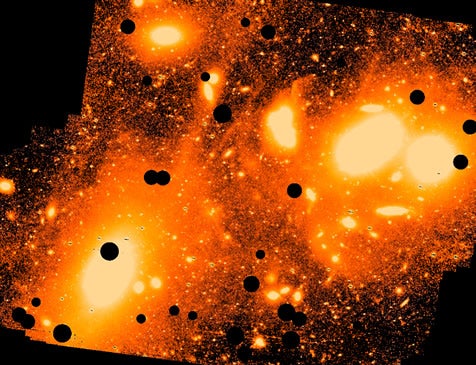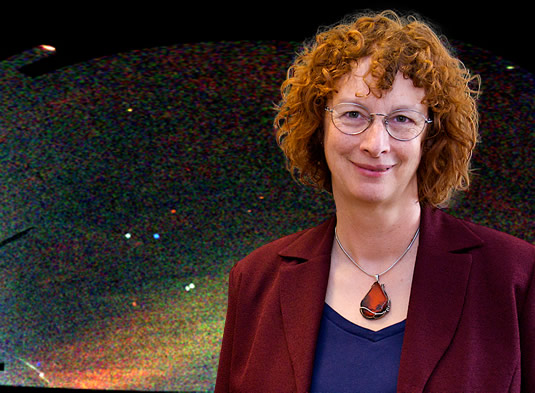Until recently, astronomers were convinced that virtually all stars were urban dwellers, so to speak, existing in vast cities of stars called galaxies. Rather like human cities on the earth, galaxies vary widely in size, shape and color. Some, like our own Milky Way, are large, beautiful spirals, populated by stars young and old. Others, shaped like footballs, cigars or spheres, are more like old-age homes, having no gas and dust from which new stars can form.
But today, we know two things that complicate this picture. First, large galaxies, with their enormous gravitational fields, sometimes attract stray, dwarf galaxies and rip them to pieces. As a result, stars that once lived in a relatively small city may whirl into the outer halo of the larger galaxy, eventually becoming part of the distant suburbs of an immense metropolis. Second, massive galaxies sometimes collide, partially tearing each other apart and leaving long trails of stars streaming in intergalactic space.
In two independent research projects, astronomers at Case Western Reserve are revealing details about the stars affected by these violent processes. Professor Heather Morrison, mining data from a digital sky survey, is studying distant stars in the outer halo of the Milky Way to deduce how many were pulled loose from smaller galaxies. Meanwhile, Chris Mihos, professor and chair of astronomy, has concluded from telescopic observations that in the nearby (cosmically speaking) Virgo Cluster of galaxies, 20 to 30 percent of the stars have been wrested from their home galaxies and are now permanently stranded in the space between them.
From Halos to Streams
In August, Morrison received a major three-year grant from the National Science Foundation (NSF) to explore the outer halo stars of the Milky Way, in part to determine how many small galaxies have been dismantled and incorporated into its halo.
"Most of my career I've spent studying the mysterious halo stars of the Milky Way," Morrison says. Having started out with basic questions about those stars, her group is now in the forefront of research into the outer halo.

Since the early 20th century, when telescopes became big enough to study galaxies in detail, astronomers have been puzzled by the fact that spiral galaxies have two distinctly different populations of stars. Bluer stars appear in the dense, bright, flat main disk of the galaxy (our sun is a disk star), while redder stars appear in a large, sparse, dim halo around the entire galaxy, including well above and below the main disk.
The star colors are significant. Spectroscopic analysis revealed that the redder halo stars were composed of hydrogen and helium, while the bluer disk stars also contained many heavier chemical elements, including iron, carbon and oxygen--elements that astronomers lump together and call "metals." From the spectroscopic evidence, mid–20th-century astronomers concluded that the Milky Way’s metal-poor halo stars must be the oldest in the galaxy, formed when the universe was mostly hydrogen.
But why would a galaxy's oldest stars be found only in the halo? That question had intrigued Morrison since she wrote her dissertation in the early 1980s. To find out more, she set out to identify and map the halo stars, using observatory photographs that had sampled parts of the heavens in various directions.
In 1993, halo stars captured the attention of all the world's astronomers when a graduate student at the University of Cambridge, mapping the velocities of stars around the center of the Milky Way, happened to discover a stream of stars on the opposite side of our galaxy. This star stream, composed largely of stars that looked like halo stars, indicated that a dwarf galaxy was on the far side of the Milky Way, hidden behind the brilliant stars and dust of the galactic center.

Astronomers realized that the Milky Way's gravitational field had generated tidal forces within this tiny galaxy, in much the same way that the moon causes ocean tides on the earth, and that these tides were strong enough to tear the dwarf galaxy apart.
This star stream is enormous. "If you stand in a dark farm field in July looking south, you will see the Milky Way arching over your head across the whole sky from south to north," Morrison explains. "What we call the Milky Way is actually the plane of the main disk of our galaxy. Now, if your eyes could see stars 100,000 times fainter, the star stream of the dwarf galaxy being ripped apart would appear to be about the same width and length as the Milky Way itself, but at right angles to it. Basically, the streaming stars are in a polar orbit up and over the disk of our galaxy."
Excited when she first heard the announcement, Morrison began to wonder: Was that grad student's discovery a fluke, or might there be other star streams around the Milky Way from other hapless dwarf galaxies that had strayed too close and been torn asunder? How many of the Milky Way's halo stars came from such events, compared to those that had formed in place? What could the speed and directions of the halo stars’ movement reveal about possible dismantlings? Answering such questions would require identifying and mapping halo stars across the entire heavens, not just in selected directions.
That is why, in 2005, Morrison began analyzing data from the Sloan Digital Sky Survey (SDSS), a monumental survey of the entire northern heavens above and below the plane of the Milky Way's disk. The SDSS is funded by the Alfred P. Sloan Foundation and 22 U.S. and international organizations. In September of this year, Morrison was awarded the status of an SDSS “Architect” in recognition of her association with the survey and her important work.
Halo stars are so faint and few—only about 0.1 percent of visible stars—that "most of the stars we see in the sky are disk stars," Morrison says. Moreover, "stars don't wear handy little signs saying 'I am a disk star' or 'I am a halo star.' So we must identify halo stars indirectly—for example, by their colors or the chemical elements in their spectra, and by their velocities." Data from the SDSS makes this kind of indirect identification possible.
Thus, for their current research, Morrison, graduate assistant Zhibo Ma and undergraduate researcher Bill Janesh '11 never set foot inside an observatory dome or lay hands on a telescope. Instead, they spend their days in front of computers, culling through the masses of spectroscopic data. The NSF grant will make it possible for her team to identify and study most of the Milky Way's halo stars visible from the northern hemisphere, using the two latest collections of images and data just released by the SDSS.
But identifying which stars are halo stars is only the beginning. Their orbital motions and velocities "preserve all kinds of information about where they come from and what happened to them in the past," Morrison says. "From that information, we hope to run the movie backwards, so to speak, to see how many other dwarf galaxies may have been tidally ripped apart as they fell into toward the Milky Way." She smiles: "We're going to find more star streams!"
A Wide Field of View
Meanwhile, Mihos, just down the hall from Morrison, is working on what started as a completely unrelated line of research.
Over time, throughout the universe, "there has been a constant dance of galaxies being pulled together by gravity to form galaxy clusters," Mihos says. "I began to wonder whether one could use a telescope to look for relics of this process."
He had an idea of what such relics might look like. Many photographs show that colliding galaxies pull stars and gas from each other in tidal tails that can be much longer than the diameter of either galaxy. Suppose that in a cluster of hundreds of galaxies, collisions were happening all the time. "Might there be tidal tails all over the place, with streams of stars from different collisions getting mixed all together?" Mihos asks.
The cluster of galaxies nearest to us is the Virgo Cluster, some 1,500 galaxies gravitationally bound into one system. It is so big that if one could look up and see those galaxies with the naked eye, “they would extend over an area in the sky 12 full moons—6 degrees—across,” Mihos says. For this reason, he would need a telescope with an unusually wide field of view.

This wasn’t the only challenge Mihos faced. Although the Virgo Cluster is quite close to us in cosmological terms—a mere 800 million light-years away—it is far too distant for even a large ground-based telescope to see individual stars and conduct spectroscopic analysis of the starlight. So Mihos relies on a clever trick. "We can't see individual stars, but we do see their integrated light as a kind of glow around each galaxy," he explains. Long photographic exposures would reveal whether the glow extends far out from the galaxies, including in any relic tidal tails. Mihos also hoped the color of the glow would indicate the types of stars in those tails.
To capture such ultrafaint features, however, the telescope would have to be located at an extremely dark site, and researchers would need exclusive access to it for at least six weeks each spring, when the Virgo Cluster is high in the night sky.
Fortunately, Case Western Reserve owns a wide-field telescope in a dark site: its vintage Burrell Schmidt telescope, now at Kitt Peak National Observatory in Arizona. This telescope has been heavily modified by observatory manager Paul Harding to increase the sensitivity of the telescope's camera and allow it to detect faint star streams. In work funded by NSF, Mihos's students and Harding take several hundred images of the Virgo Cluster over many weeks, each with an exposure time of about 15 minutes. These images are then digitally combined to create one ultralong exposure, which captures the faint light of any stars between galaxies.
The long-exposure images have indeed revealed a tracery of tidal tails throughout the Virgo Cluster. In fact, "it seems that as many as 20 or 30 percent of the stars in the Virgo Cluster may exist outside of the galaxies," Mihos says.
The colors of the tidal tails drifting across the cluster imply that, like the Milky Way star streams Morrison is researching, they consist mostly of older red, metal-poor stars. Observes Mihos, "That's a satisfying bit of confirmation that what is going on here in the Milky Way is similar to what is going on in the rest of the universe."
Science journalist Trudy E. Bell was a Presidential Fellow in Spring 2010, leading the SAGES seminar "Political Hype vs. Science Fact: Evidence, Risk, Preferences, Values, and 'Spin.'"

